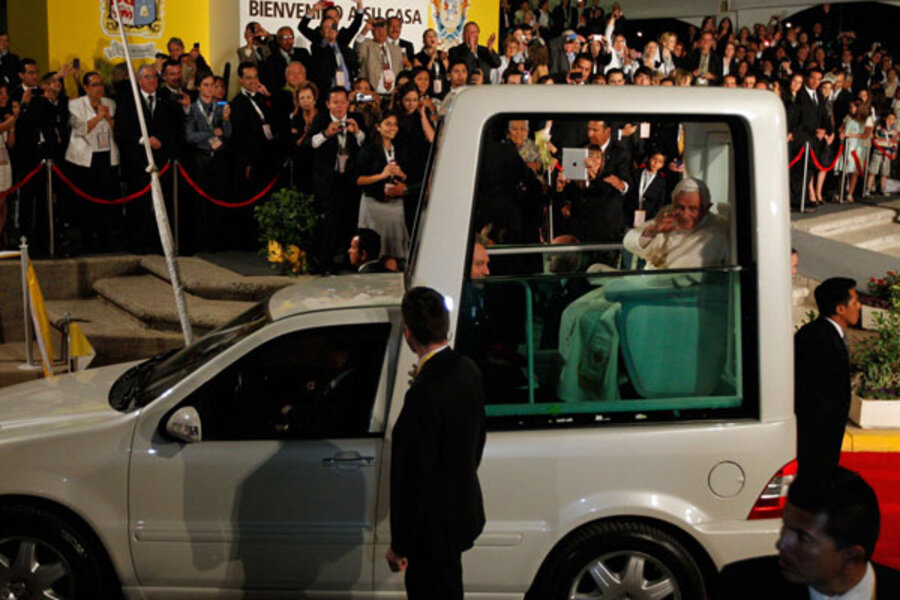Mexicans host Pope Benedict XVI, but say he's no Juan Pablo
Loading...
| Mexico City
There is really no better place to measure the pulse of a country than in a beauty salon. And in Mexico City, in Vanessa Gonzalez's salon, the trip of Pope Benedict XVI to Mexico measures at, she pauses, approximately zero. “I have not heard one client talking about it,” she says.
But during the last papal visit to this country ten years ago – by the late Pope John Paul II – the swirling chairs and shampoo stalls were abuzz. “People adore Juan Pablo,” she says.
Pope Benedict XVI arrived in Mexico on Friday, and today celebrates an open mass in a park in Silao, Guanajuato, a deeply Catholic state in central Mexico, before heading on to Cuba tomorrow.
His trip has not been without controversy. He comes amid gruesome drug violence that has claimed 50,000 lives, and while most victims are rival traffickers, anyone can end up a target, including a public figure. He is bypassing Mexico City altogether, leaving some residents feeling snubbed and others speculating that he is avoiding the capital's embrace of gay marriage and abortion (the Vatican says the altitude is what's keeping him away). And Guanajuato state happens to be run by the ruling, Catholic-friendly National Action Party (PAN), which some see as a political message. They say it's no coincidence that the pope is visiting the country as it is about to kick off its presidential race.
But away from the political chatter, regular Mexicans are hardly paying attention. Mexico is devoutly Catholic, home to the second-largest Catholic population in the world behind Brazil. But the current pope has done little to move Mexican Catholics the way his predecessor did – John Paul II often brought the faithful to tears.
Ms. Gonzalez says even her father, a man not easily moved, broke down crying upon passing a caravan carrying John Paul II on his first-ever trip to the nation in 1979. He would visit Mexico five times in total.
Her mother, meanwhile, is devoutly Catholic and easily moved, praying a full hour each morning and another hour each night. But she hasn't even talked about Benedict XVI's visit – Gonzalez didn't even exactly know when he was scheduled to arrive. If it were John Paul II, she says, she'd probably know his entire itinerary.
In fact, mention the current pope and the first words out of everyone's mouth is “seco,” meaning dry. That's usually followed by “serio,” or serious. Some say he seems harsh, and most of all, he's not “charismatic.”
“He doesn't have charm,” says Julio Valdez, a parking valet outside a local Catholic parish.
“I don't know anything about this pope,” says Elizabeth, who makes tortillas outside the same church and says she's too shy to share her last name. “Everything that John Paul did and said was good, just good,” she says, her face lighting up. “You just say his name, and I am full of emotion.”
Their feelings are reflected in a survey by Demotecnia, which showed that 77 percent of Catholics surveyed said that if they are moved at all by the pope's visit, it doesn't compare to how they felt ahead of John Paul II's visits. Only 20 percent of Catholics polled said they were “very excited” about the trip.
A good portion of those must live in Guanajuato. The state hosting Benedict this weekend is among the most religious in Mexico, with 94 percent calling themselves Catholic, according to the Mexican census. It may be a coincidence but when the Monitor was recently in Guanajuato to write about the pope's visit, the first three people interviewed were named in order: Jesus, Magdalena, and Moises.
Moises Silva, leaving the main basilica of the state capital Guanajuato on Ash Wednesday, said he was planning on battling the mobs to capture a glimpse of the pope. “It is a blessing that he is going to visit,” said Mr. Silva.
Magdalena Vargas, a city accountant, said her feelings of joy were “infinite.” “One can hardly believe that the highest representative is coming here,” she said. “We are overjoyed.”







